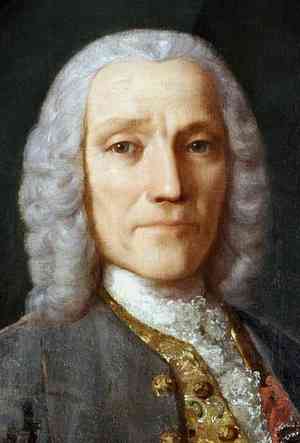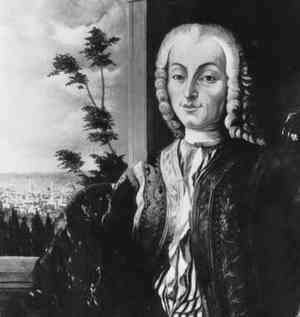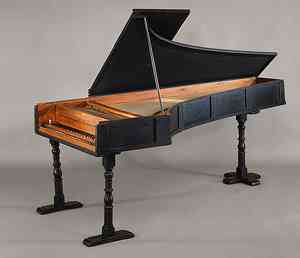


Domenico Scarlatti
Source:
Opi Wiki
Born 26 October 1685 in Naples, Domenico Scarlatti was an influential late baroque composer at root to the galant and classical styles, he bridging to them both. They are much Scarlatti's 555 keyboard sonatas produced in Madrid that illuminated the court of Spain during the late baroque period and wrought novel approaches contributing to the golden period of the classical just a breath in time ahead. As the son of Alessandro Scarlatti, Domenico had a heady act to follow, and excelled. One cause of Scarlatti's significance is his connection to Spain. Spain had produced a few composers during the Renaissance (Tomás Luis de Victoria), but it was something in the suburbs like Poland in comparison to the continent, more than a thousand miles from Germany. The hot spots of baroque activity were in France, Germany, Italy and Venice, England less so. Despite the Habsburg Holy Roman Empire contending with Protestant Germany in alliance with Papal states, Venice and Spain, Spain and continental Europe were two different worlds. The distance of Poland and Spain from Europe's main cultural centers doesn't mean, however, that they lagged behind the rest of Europe. Both, especially Spain, were as baroque on their own terms as you could wish a place to be by Domenico's time. Viewing Portugal south of the Pyrenees, natural border to the continent, as a smaller version of Spain, Scarlatti's traveling arrival there in 1719 was a main event in musical history.
We should preface this glance at Scarlatti with a look at cataloguing systems of which there are four. The earliest is the 'CZ' indexed by composer, Carl Czerny, at an unidentified time. 'L' numbers are by Alessandro Longo as of 1905. The 'K' directory is by Ralph Kirkpatrick [Wikipedia] as of 1953. 'P' numbering is by Giorgio Pestelli as of 1967. See also CZ-K-L-P; K; K-L-P; K vs sources; L.
Scarlatti had worked as a composer and organist in Naples as early as 1701, composing a motet for the Feast of John the Baptist that year. From 1703 to 1757 Scarlatti composed eighteen operas beginning with 'Ottavia restored to the throne' and 'Giustino' the same year.
'L'Ottavia restituita al Trono' Opera by Domenico Scarlatti
'Ottavia returned to the Throne'
Premiere Naples 1703 Libretto: Giulio Convò
Cappella Della Pietà De'Turchini / Antonio Florio
Soprano: Yolanda Auyanet (Ottavia)
After a few years in Naples Scarlatti's father sent him to Venice, he not raising his head again until 1709 in Rome in service to Queen Marie Casimire, she in exile from Poland. Casimire commissioned seven operas from Scarlatti, his first a pastorale called 'La Silvia' premiering on 27 Jan 1710. His second, 'Tolomeo e Alessandro', was staged on 19 January 1711. His last before Casimere's departure to France in flight from debt was 'Amor d'un'ombra e gelosia d'un'aura', aka 'Narciso', performed at her private theatre in January 1714. Other early works had appeared during this period such as a 'Salve Regina' in 1712.
Scarlatti wrote his 'Christmas Cantata' in Rome in 1714, that among about 800 cantatas most of which are of unknown date. Scarlatti had become employed at the Cappella Giuiia at St. Peters in 1714, appointed maestro in December, which position he held until 1719. It was probably during that period that his setting for 'Iste Confessor' appeared as well as a couple 'Miserere's ('Psalm 51'), his 'Magnificat' and his 'Stabat Mater'. The 'Magnificat' is a canticle (text from the Bible) of Mary setting music to verses from the gospel of 'Luke'.
'Magnificat' Liturgical work by Domenico Scarlatti
Composed for 4 voices prob Rome sometime 1714-1719
Canticle of 'Luke' 1:46-55 Score
Immortal Bach Ensemble / Morten Schuldt-Jensen
Scarlatti possibly crossed the Channel to London in 1715 to stage 'Narciso' at the King's Theatre [Wikipedia]. He traded his position at St. Peter's for an appointment as tutor to Barbara of Portugal [Wikipedia] in Lisbon in 1719. His liturgical 'Te Deum' was probably performed in Lisbon in latter 1721.
'Te Deum' Liturgical work by Domenico Scarlatti
Premiere Lisbon 1721
Composed for 8 voices w organ Text by unknown sometime 4th century Score
Immortal Bach Ensemble / Morten Schuldt-Jensen
Scarlatti left Lisbon for Rome in 1727 where he married one Maria Caterina Gentili on 6 May 1728 with whom he would have five children. Moving to Seville in 1729, in 1733 he became employed to Barbara again, this time in Madrid, she now married into the Spanish royal house, to become Queen of Spain in 1746. Scarlatti found little argument with this situation for the remaining quarter century of his career.
Born during the same year as Scarlatti (26 October 1685) were Handel (5 March), J.S. Bach (31 March) and Lodovico Giustini on 12 December. Albeit originating when all were about fifteen years of age none but Giustini composed for piano, the instrument yet too imperfect for the others. Giustini is, indeed, credited with the first known compositions specifically for piano rather than harpsichord per his '12 Sonate da Cimbalo di piano e forte' published in Florence in 1732. Scarlatti's connection to piano is by virtue of Barbara who would own five pianos among twelve keyboard instruments at the time of her death in 1758. Scarlatti was no doubt familiar with the early piano, its existence likely of some affect in his composing, but it wasn't yet capable of what a harpsichord could do so he wrote keyboard pieces for harpsichord or organ only. He is commonly recorded on piano by virtue of his familiarity with the instrument at the court of Barbara.
The piano was called a "gravicembalo col piano e forte" ("keyboard instrument with soft and loud" by its inventor, Bartolomeo Cristofori, who presented his instrument to Ferdinando de' Medici of Tuscany in Florence in 1700. Gravicembalo translates to harpsichord in Italian. The basic difference between harpsichord and piano is that one plucks strings while the other hammers them. Three pianos that Cristofori made in the 1720s yet exist. Despite the first piano arriving in 1700, its development toward the instrument that would replace the harpsichord took perhaps a hundred years. Haydn composed for piano as early as the 1760s, Beethoven as a teenager in the 1880s, and Mozart used the instrument during the last decade or so of his career before his death in 1791. These were lighter and lesser developed instruments than the grand piano which Steinway introduced in America in 1840. A particularly nice marker of piano finally coming of age after a century of development by various in succession is Beethoven's 'Moonlight Sonata' written for piano in 1801, not nearly so romantic on a harpsichord. Beethoven loved the piano for which composed, ever looking for someone who could make a better instrument. Another generation and piano had put harpsichord where you could see it in your rearview mirror from the Romantic period during which the instrument took front stage. Compare the harpsichord to the clavichord to the fortepiano.

Bartolomeo Cristofori
Inventor of the piano in Florence in 1700
Source: Musica En El Mateo

Cristofori Grand Piano 1720
Source: The Met
'12 Sonate da cimbalo di piano e forte' Lodovico Giustini
Earliest known composition for piano published 1732 in Florence
Pianoforte: Andrea Coen Score to Op.1
Scarlatti published his 'Essercizi per Gravicembalo' ('Exercises for Harpsichord') in London on 3 February 1739 dedicated to John V of Portugal. Little of Scarlatti's oeuvre has taken the globe by storm with the exception of his harpsichord sonatas which are long since a deep study and by far his most esteemed works. Beginning the Kirkpatrick catalogue with 'Sonata in D minor' as K 1 (CZ 6 / L 366 / P 57), the last of thirty sonatas in 'Essercizi per Gravicembalo' is Scarlatti's famous 'Cat Fugue' (Fugue in G minor) K 30 / L 499. Scarlatti's second volume of sonatas saw print the same year with the edition of 12 more in '42 Suites de Pièces pour le Clavecin' K 1-42 [score]. The remainder of Scarlatti's 550 sonatas per Kirkpatrick have their sources in manuscripts. Via study of key signatures Christopher Hail has attempted to divide these sonatas into periods of 1715-1725, 1725-1730, 1730-1735, 1735-1740 and 1740-1755. Scarlatti wrote sonatas for Barbara whom must thus assume to have been a capable keyboardist, having played the harpsichord for at least a quarter of a century before becoming Spain's Queen (1746).
'Essercizi per Gravicembalo' K 1-15 Domenico Scarlatti
Published London 1739
Harpsichord: Scott Ross
'Essercizi per Gravicembalo' 'Cat's Fugue' K 30 Domenico Scarlatti
Published London 1739
Harpsichord: Elaine Comparone
All seventeen of Scarlatti's sinfonias are found in manuscript inscribed sometime between 1750 and 1790.
'Sinfonia No.2' G major Domenico Scarlatti
Composed c 1750-1756
Gruppo strumentale “R.Dionisi” / Claudio Colmanet
To go by Wikipedia, among Scarlatti's latest datable operas was 'I portentosi effetti della madre natura' composed in 1752. As mentioned, Scarlatti had written his first 'Salve Regina' as early as 1712. Johan van Veen comments that "the last of his works, composed in Madrid not long before his death" appears on the manuscript of Scarlatti's second 'Salve Regina', placing its composition in 1756 or 1757.
'Salve Regina' Liturgical work by Domenico Scarlatti
Sometime in Madrid 1756-57
Antiphon to Mary in A major composed for soprano / strings / basso continuo
Text by unknown sometime Middle Ages
English Chamber Orchestra / Raymond Leppard 1969
Scarlatti died in Madrid on 23 July 1757.
Sources & References for Domenico Scarlatti:
Franz Gehring (A Dictionary of Music and Musicians / 1900)
VF History (notes)
Chris Whent (HOASM)
Analyses:
Sonatas:
Christopher Hail (Capriccio)
Christopher Hail (Chronology)
Christopher Hail (Cogito)
Richard Lester (Thoughts on Scarlatti's Essercizi per Gravicembalo)
Linton Powell (A History of Spanish Piano Music)
Temperament / Tuning: John Sankey
Audio of Scarlatti:
Claudio Colombo (harpsichord 2015-2019)
Collections: Christopher Hail
Compositions: Directories (Czerny ? / Kirkpatrick 1953 / Longo 1905 / Pestelli 1967):
Compositions by Genre:
Christopher Hail (sonata chronology by key)
Christopher Hail (sonata chronology by key)
Wikipedia Japanese (sonatas CZ / K / L / P)
Compositions: Publications:
Essercizi per gravicembalo / London / 1939:
IMSLP Wikipedia English Wikipedia Italian
Contemporaries:
Lodovico Giustini (1685-1743):
Daniel Freeman (Lodovico Giustini and the Emergence of the Keyboard Sonata in Italy)
Christopher Hail (various)
Discussion of Scarlatti:
guitarra.artepulsado (guitar)
Documentaries:
Domenico Scarlatti: His Music and His World (Part 1 directed by Ann Turner for BBC / 1985)
Domenico Scarlatti: His Music and His World (Part 2 directed by Ann Turner for BBC / 1985)
Piano: Development:
Alec Coles-Aldridge (Bartolomeo Cristofori's grand of 1720)
Michael Cole (fortepiano vs pianoforte)
John Mello (What's the Piano's Real Name, Pianoforte or Fortepiano?)
Wendy Powers (The Pianofortes of Bartolomeo Cristofori)
Jan Swafford (Beethoven)
Benjamin Vogal (piano e forte)
Pamela Wiggins (Is It a Piano, Pianoforte or Maybe a Harpsichord?)
Recordings of Giustini: 1732:
12 Sonate da cimbalo di piano e forte (pianoforte by Andrea Coen / 2010)
Sonate da cimbalo di piano e forte (piano e forte by Wolfgang Brunner / 2009)
Sonate da cimbalo di piano e forte (piano by Enrico Maria Polimanti / Naxos / 2014)
Recordings of Scarlatti: Catalogs:
DAHR (shellac 1917-1938)
Music Brainz (per Kirkpatrick)
Music Brainz (per Longo)
Recordings of Scarlatti: Select:
Domenico Scarlatti: Sacred Vocal Music (Immortal Bach Ensemble / Morten Schuldt-Jensen / Naxos)
Domenico Scarlatti: Stabat Mater (Vox Luminus on Ricercar 2008)
Salve Regina (King's Consort directed by Robert King / Helios / 1996)
Salve Regina (Orquestra Barroca de Sevilla directed by Nicolau de Figueiredo / 2007)
Scarlatti: 52 Sonatas (piano by Lucas Debargue / 2019)
Scores / Sheet Music:
IMSLP Musicalics (vendor)
Editions:
Abe Books (vendor)
Edited by Giuseppe Buonamici / G. Schirmer / New York 1895
Edited by Kenneth Gilbert / Le Pupitre / Heugel / Paris / 1971-1984
Further Reading:
Georg Predota (Mapping the Musical Genome: The Scarlatti Family)
Robert White (The mercurial maestro of Madrid)
Bibliography:
Laura Crow (Progress towards the idiomization of piano language through Clementi's edition of the sonatas by D. Scarlatti in 1791 / Anuario Musical / 2017): Anuario Musical ResearchGate
Ralph Kirkpatrick (Domenico Scarlatti / Princeton University Press / 1953)
W. Dean Sutcliffe (The Keyboard Sonatas of Domenico Scarlatti / Cambridge University Press / 2008)
Michael Talbot (review of Sutcliffe / University of Liverpool)
Authority Search: VIAF World Cat
Other Profiles:
Associazione Domenico Scarlatti
Classical Main Menu Modern Recording
hmrproject (at) aol (dot) com